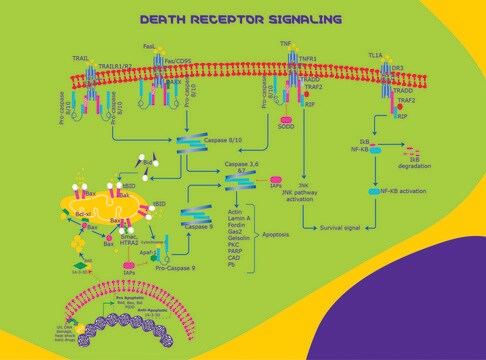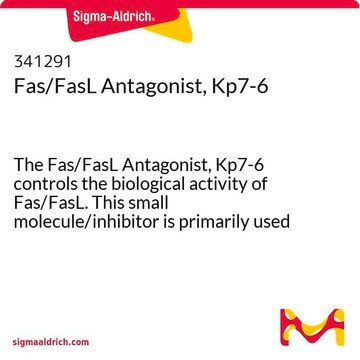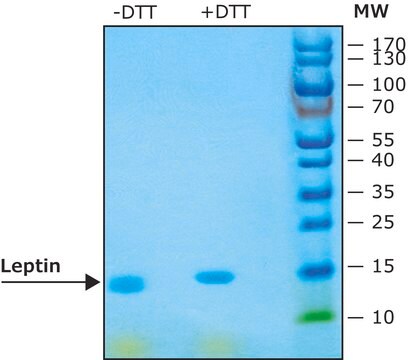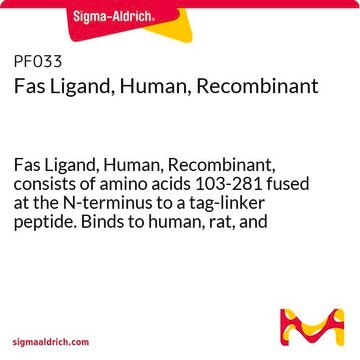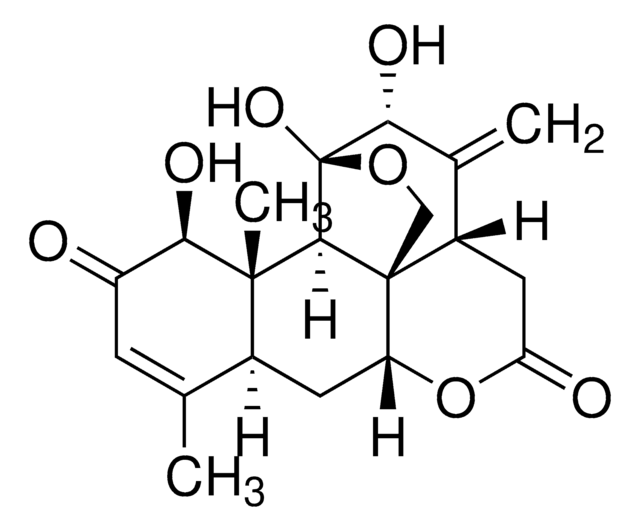Wszystkie zdjęcia(1)
Kluczowe dokumenty
F0552
Fas Ligand from mouse
>95% (SDS-PAGE), recombinant, expressed in mouse NSO cells, lyophilized powder
Zaloguj sięWyświetlanie cen organizacyjnych i kontraktowych
About This Item
Polecane produkty
rekombinowane
expressed in mouse NSO cells
Poziom jakości
Próba
>95% (SDS-PAGE)
Formularz
lyophilized powder
masa cząsteczkowa
monomer calculated mol wt ~18 kDa
28-32 kDa by SDS-PAGE
zanieczyszczenia
endotoxin, tested
numer dostępu UniProt
temp. przechowywania
−20°C
informacje o genach
mouse ... Fasl(14103)
Opis ogólny
FASLG (Fas ligand) działa jako ligand dla receptora Fas i jest głównym białkiem zaangażowanym w zaprogramowaną śmierć komórki, apoptozę. Rozpuszczalny Fas (sFAS) jest zwykle wykrywany w osoczu przed apoptozą.
Zastosowanie
Ligand Fas (FASLG) pochodzący od myszy został użyty do
- indukcji apoptozy w komórkach PC12 i
- indukcji migracji w mysich komórkach mikrogleju BV-2.
Działania biochem./fizjol.
Białko należące do rodziny cytokin czynnika martwicy nowotworów (TNF); indukuje apoptozę w komórkach wyrażających receptor błony komórkowej Fas (CD95/Apo-1).
FASLG (Fas ligand) i receptor Fas stanowią podstawowe elementy apoptozy. Interakcja FASLG z receptorem Fas prowadzi do aktywacji kaspazy-8. Kaspaza ta z kolei prowadzi do aktywacji kaspaz efektorowych, takich jak kaspaza-3, -6 i -7. Kaskada ta skutkuje hydrolizą składników jądrowych i cytoplazmatycznych. Ekspresja FASLG jest indukowana przez czynnik jądrowy-κB (NFκB). Szlak NFκB/FASLG ułatwia tłumienie toksyczności komórek indukowanej p,p′-DDT (dichlorodifenoksytrichloroetanem) przez witaminę C i E. W komórkach T CD4+ białko to ulega ekspresji pod wpływem stymulacji przez receptor komórek T (TCR), zarówno w warunkach normalnych, jak i patologicznych, takich jak ekspozycja na alkohol.
Ligand Fas, białko należące do rodziny cytokin czynnika martwicy nowotworów (TNF), indukuje apoptozę w komórkach wykazujących ekspresję receptora Fas (CD95/Apo-1).
Inne uwagi
Mouse Fas Ligand, N-terminal 6X histidine-tagged, encodes amino acid residues 132-279.
Postać fizyczna
Lyophilized from a 0.2 μm filtered solution in phosphate buffered saline containing 2.5 mg bovine serum albumin.
Komentarz do analizy
Measured by its ability to induce apoptosis in Jurkat cells.
Ta strona może zawierać tekst przetłumaczony maszynowo.
Kod klasy składowania
10 - Combustible liquids
Klasa zagrożenia wodnego (WGK)
WGK 3
Temperatura zapłonu (°F)
Not applicable
Temperatura zapłonu (°C)
Not applicable
Wybierz jedną z najnowszych wersji:
Masz już ten produkt?
Dokumenty związane z niedawno zakupionymi produktami zostały zamieszczone w Bibliotece dokumentów.
Xiaoting Jin et al.
PloS one, 9(12), e113257-e113257 (2014-12-03)
Dichlorodiphenoxytrichloroethane (DDT) is a known persistent organic pollutant and liver damage toxicant. However, there has been little emphasis on the mechanism underlying liver damage toxicity of DDT and the relevant effective inhibitors. Hence, the present study was conducted to explore
Aleksander Szymanowski et al.
Atherosclerosis, 233(2), 616-622 (2014-02-19)
Apoptosis of natural killer (NK) cells is increased in patients with coronary artery disease (CAD) and may explain why NK cell levels are altered in these patients. Soluble forms of Fas and Fas ligand (L) are considered as markers of
Nicole Suyun Liu et al.
PloS one, 7(8), e43180-e43180 (2012-08-21)
Diva is a member of the Bcl2 family but its function in apoptosis remains largely unclear because of its specific expression found within limited adult tissues. Previous overexpression studies done on various cell lines yielded conflicting conclusions pertaining to its
Ying-mei Lu et al.
Journal of neuroinflammation, 9, 172-172 (2012-07-14)
The cerebral microvascular occlusion elicits microvascular injury which mimics the different degrees of stroke severity observed in patients, but the mechanisms underlying these embolic injuries are far from understood. The Fas ligand (FasL)-Fas system has been implicated in a number
Smita S Ghare et al.
Journal of immunology (Baltimore, Md. : 1950), 193(1), 412-421 (2014-06-06)
Activation-induced Fas ligand (FasL) mRNA expression in CD4+ T cells is mainly controlled at transcriptional initiation. To elucidate the epigenetic mechanisms regulating physiologic and pathologic FasL transcription, TCR stimulation-responsive promoter histone modifications in normal and alcohol-exposed primary human CD4+ T
Nasz zespół naukowców ma doświadczenie we wszystkich obszarach badań, w tym w naukach przyrodniczych, materiałoznawstwie, syntezie chemicznej, chromatografii, analityce i wielu innych dziedzinach.
Skontaktuj się z zespołem ds. pomocy technicznej